This was published 4 years ago
'I like being in people's heads. I feed off it': how putting the macabre back into music paid off for Billie Eilish
She tends towards the melancholy and bizarre, but the planet’s hottest pop star has swept the Grammys and smashed music charts. How has a love of “freaking people out” reeled so many in?
By Jonah Weiner
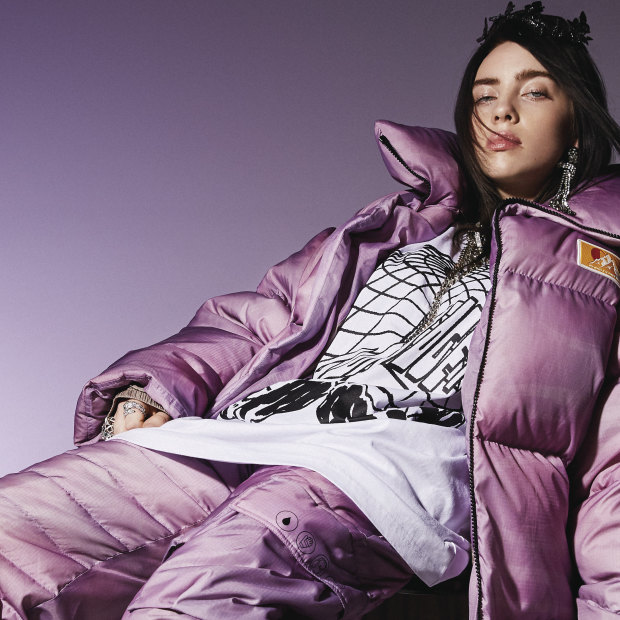
Billie Eilish: "I love bugging people out, freaking people out. I like being looked at."Credit: Jesse Lizotte/Trunk Archive/Snapper Images
Sometime during the night of September 4, 2018, Billie Eilish took her own life – in a dream. “I jumped off a building,” she recalled recently. What was most alarming about it, as she looked back, was how little it alarmed her. “I was in a really bad place mentally,” Eilish said; the dream struck her less as a nightmare than as a grimly alluring fantasy.
The next day, she approached her older brother, Finneas O’Connell, a songwriter and producer, and told him about it. They have collaborated on every piece of music she has put out, and she presented the dream to him as possible inspiration for a new song.
Eilish, whose full name is Billie Eilish Pirate Baird O’Connell, was raised in a two-bedroom, 111-square-metre Craftsman bungalow in a modest neighbourhood on Los Angeles’s east side. In 2018, Finneas bought a house of his own, but his childhood bedroom, abutting Billie’s, has long been their favourite place to make music. (Their parents, working actors who augmented their income with side jobs in construction and teaching, still sleep on a futon in the living room.)
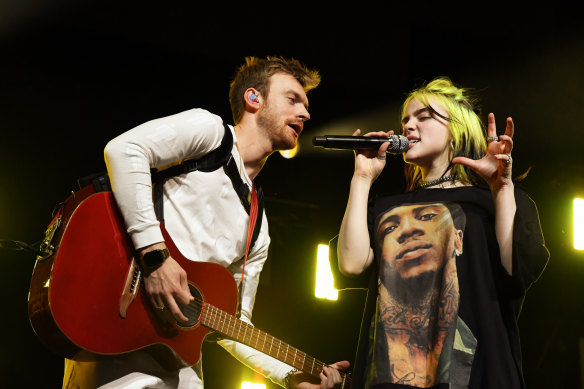
Eilish and her songwriting brother Finneas: they have collaborated on every piece of music she has put out.Credit: Getty Images
Finneas, facing a keyboard, listened as Billie talked about her dream, and together they figured out some chords to frame Billie’s deceptively upbeat opening line – “I had a dream I got everything I wanted.” As they worked on the song, though, Finneas grew increasingly uncomfortable, then angry, and finally he refused to go any further.
“We had this big argument,” Billie said. “Because I admitted something that I was, uh. It wasn’t a physical thing I was admitting. I don’t know how to put it without actually saying it, and I don’t want to actually say it. But it was me admitting to something that was very serious about my depression. A very serious step that I was admitting that I was planning on taking. And Finneas said, ‘I don’t want to write a song about you killing yourself and how that’s everything you wanted!’ ”
Her parents caught wind of the argument and, along with Finneas, grew “insanely concerned”, Billie said. “It became this huge thing, and I locked myself in my room, and I was in there, just drawing on my wall.”
Recounting this episode, Billie sat cross-legged on the living-room couch at Finneas’s house, mashing her mismatched Air Jordan 1s into the cushions. Her hair was dyed ink-black with a seepage of acid green at the scalp, and she wore an all-black outfit: an oversize bowling shirt printed with an image of two women, wearing crowns, covered in blood and kissing, and cargo pants that, in their stylised profusion of straps and pockets, struck a compromise between goth and SWAT.
As she spoke, I could see her left eyebrow twitching – Billie has been given a diagnosis of Tourette syndrome, which manifests mainly in facial tics and muscle tensing.
She had barely finished the story when Finneas himself walked through the front door. In 2019, he moved to yet another house, with his girlfriend, and repurposed this one as a place to hang out and record – it has also served as a “safe spot”, as Billie put it, since the address of the family bungalow leaked online last year.
Even for a place no one calls home anymore, Finneas’s house felt notably bare. On a table in the centre of the living room were a computer and a microphone. Pressed against the far wall was an upright Kawai piano. The sole decorations other than a thirsty-looking potted plant were two black-and-white photos depicting the Yosemite Valley, of the sort you might find hanging above the coffee machine at a business hotel, and a red neon sign spelling out “10,000 Hours” – the pop-science creative-labour catchphrase made famous by Malcolm Gladwell – that would fit in nicely above the kombucha tap at a co-working space.
In her videos, which she occasionally directs herself, she has cried black tears and released a large spider from her mouth.
Billie, 18, and Finneas, 22, have an easy, unabashed intimacy. They were home-schooled, and Billie likes to joke that had they ever attended public schools, Finneas – eccentric and sweet-natured – would have been bullied, whereas Billie – coolly charismatic and sharp-tongued – would have been a bully.
In conversation, though, they’re more likely to pay each other compliments, plainly and earnestly, than to reroute their affection through the kinds of sarcastic needling siblings often engage in. Finneas, leaning over the couch in an extremely LA ensemble – multicoloured camp shirt, skinny trousers, perforated brown loafers with no socks – gave Billie a hug.
“Missed you,” he said, to which she replied, “You smell good.” He took a seat on a coffee table facing her, and she stretched out a leg so that her right foot rested on his left inside thigh.
Seeing Eilish interact so unguardedly with her brother, you can forget that she is one of the planet’s biggest pop stars, measured either by streaming-era metrics or the oldest, crustiest yardsticks in the business.
Her songs have earned more than 15 billion combined streams worldwide, according to Spotify, and her five most-watched videos on YouTube have some 2.5 billion views in all. Eilish’s first album, When We All Fall Asleep, Where Do We Go? made its debut last year at No. 1 on the Billboard 200 albums chart, and when her biggest single to date, Bad Guy, rose to No. 1 on the Hot 100 pop chart in August, it dethroned the epochal hit Old Town Road, by her fellow Gen Z luminary Lil Nas X.
“I’m not going to lie in a song and talk about how I’m feeling good when I’m not …”
Billie Eilish
In January, Eilish swept the top categories at the Grammys, including song of the year, record of the year and album of the year. That same month, the Oscars booked her to sing during the In Memoriam section; MGM and Eon, meanwhile, asked her to write and sing the theme song for the next James Bond movie.
As today’s pop superstars go, Eilish is remarkable for her abiding interest in the grim and the upsetting. She has resuscitated an aesthetic of macabre transgression that has been almost entirely absent from the musical mainstream since the ’90s heyday of rock acts like Nine Inch Nails and Marilyn Manson.
In her lyrics, narrators murder their friends and liken lovers to hostages. In her music, bright singalong hooks are subsumed by bursts of distortion, and whisper-quiet verses are interrupted by shrieking samples of a dentist drill.
In her videos, which she helps to devise and occasionally directs herself, she has cried black tears and released a large spider from her mouth. In one, faceless tormentors burn her with cigarette butts; in another, they jab her with syringes.
All this reflects an entertainer’s conscious strategy to inspire titillated repulsion in audiences – to seduce and ensnare fans the way a horror auteur does. “I love bugging people out,” Eilish told me. “Freaking people out. I like being looked at. I like being in people’s heads. I feed off it.”
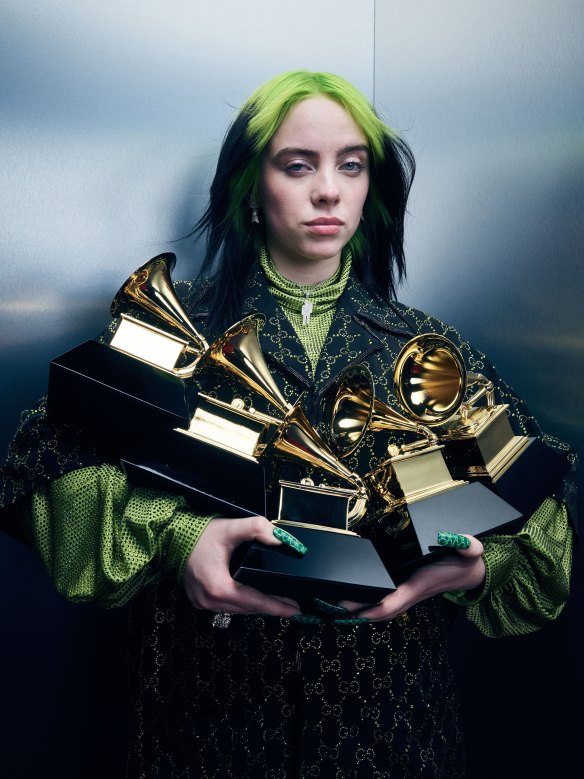
Eilish cleaned up at the Grammys in January. At one point, however, she said the impact of fame made her feel like she was “in jail”.Credit: Robby Klein/Contour by Getty Images for The Recording Academy
But it also connects to her tendencies toward melancholy and depression, which Eilish says songwriting helps her to navigate and, ideally, helps listeners relate to her music that much more profoundly. “I want to be the voice of people,” she said at one point.
What she hadn’t considered when she brought her dream of suicide to Finneas, though, was the toll that hearing and helping to craft such music might take on those who love her most.
“We haven’t really talked about this since, but Finneas was like, ‘I don’t want to keep making these songs that are only sad and they never get better,’ ” Eilish said. “He wanted to make songs that resolve in the end. I was like: ‘But Finneas, that’s not how things work in life. And I’m not going to lie in a song and talk about how I’m feeling good when I’m not …’ ”
Sitting on the coffee table, Finneas nodded, reaching over to pick up a piece of crud that Billie’s soles had deposited on the couch.
“It was a period where I was really worried about my sister, and I felt like an enabler in helping her write a song as bleak as that song was,” he said. “Like the musical equivalent of giving an alcoholic another beer: ‘I’m not going to support this.’ A lot of songs are written in retrospect, but this one felt like it was being written in real time, and I was like: ‘This is something we’ve got to write on the other side of this hill. We have to go through this in real life. You can’t always solve your problems in a song ...’ ”
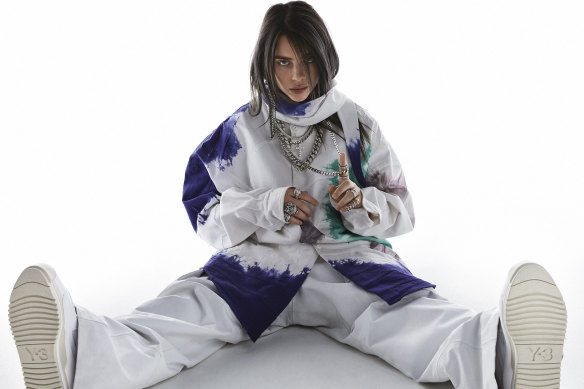
Much of her “darker” music is, in fact, cathartic, her mother says of Eilish: “She’s not writing it to feel worse, she’s writing it to feel better.”Credit: Jesse Lizotte/Trunk Archive/Snapper Images
When I first met Eilish at the family bungalow in December 2018, three days after her 17th birthday and three months before the release of When We All Fall Asleep, Where Do We Go? she was already a streaming sensation, with a major-label contract and a catalogue of sparse, synthesiser-driven singles stretching back to her breakthrough, a lovely ballad called Ocean Eyes, which she and Finneas uploaded to SoundCloud in 2015.
Her album was close to complete, but the final leg of the process had been excruciating – “an endless-limbo thing”, Eilish said. “Unfinished things are nice if you have an idea where you’re going to go with them, but if you have no clue?” She bugged her eyes in a pantomime of distress.
The bungalow was invitingly cluttered, with bric-a-brac on the mantels, musical instruments everywhere and friendly pets underfoot – a rescue cat named Misha, a shelter dog named Pepper. Eilish’s parents, Maggie Baird and Patrick O’Connell, zigzagged around, tending to household tasks, cheerfully checking in on Eilish, asking me if I needed another glass of water. Their backyard was spacious and sunny, occupied in one corner by a soundproof shed where Patrick sometimes recorded audiobook narrations and other voice-over gigs.

The siblings – Billie and Finneas – with parents Maggie Baird and Patrick O’Connell at Billboard Women in Music 2019. Credit: Getty Images
Finneas, a one-time actor whose resumé includes a role on Glee, told me that when he and Eilish were younger, money was often tight.
“Our parents had enough trouble supporting themselves and our family, strictly off of income as artists,” he said. “Our dad worked as a carpenter, and our mum taught a ton of improv and aerial classes on the side. My hope was that they were doing things that gave them some level of satisfaction, like, our dad genuinely loves carpentry, but yeah, having struggling-artist parents was depressing.”
He emphasised, though, that while “money was definitely a dictator of stress – we witnessed our parents stressed about, Man, if we don’t work this many hours this month, it’ll be really hard – money has absolutely not been the dictator of happiness in our lives. Our parents never presented it to us that way.”
Eilish showed me her room, a small space made to feel that much smaller by the reams of luxury apparel various fashion designers and athletics brands had sent her in the hope that she might wear them on TV or Instagram.
“It’s too much,” she said. Case in point: dozens and dozens of rare and in some cases unreleased sneakers – I lost count after the 49th pair – sat in tidy rows covering the floor with the narrowest of paths snaking between them. “Those go for, like, $2000,” Eilish said, pointing downward.
“I’ve always been really stoic. I never tell people when I’m in pain, and I’ve always been in some sort of pain.”
Billie Eilish
Sidestepping Balenciaga Triple Ss and Travis Scott Jordans, Yeezys and Off-White Air Maxes, Eilish made it to the other end of the room to retrieve her notebook – “the most valuable thing I have,” she said, “because it’s where I’ve written down every idea.”
Angling it for my benefit, Eilish flipped through the scrawled protolyrics and heavy black line drawings within – syringes, shadowy hallways. “These are intestines and stuff.” Flip. “This is a song we haven’t finished.” Flip. “This is the bridge of Bury a Friend” – one of Eilish’s biggest singles, whose darkest refrain, “I wanna end me,” she had written hundreds of times in tiny letters, the words piled into a tottering heap.
A few pages later, I caught the phrase “I feel I am dissolving.” Self-obliteration was a recurring theme in the notebook, as it is in Eilish’s music. So were sexual desire and body horror, and the slippage, as Eilish saw it, between them. She lingered a bit over two naked women she had drawn, one with a classically proportioned face and a deformed, reptilian body, the other with grotesque facial features and voluptuous curves.
“This is an interpretation of the world,” Eilish said, “because they’d have sex with a monster if her body looked like that, but they wouldn’t have sex with a beautiful girl if her body looked like that.” She put down the notebook and raised a dark-coloured curtain she had nailed up beside her bed, behind which, it emerged, her drawings and nihilistic scribblings had escaped the notebook and were spreading across the wall. Eilish laughed. “There’s a lot more behind the pillows,” she said.
Eilish’s history of depression began in early adolescence, when she ruptured the growth plate in her hip while dancing – something she loved doing so much she had joined a company, which, painfully and abruptly, she was then forced to quit.
“My bone separated from the muscle, so that took me out,” she said. Eilish has long felt uncomfortable in her own skin, in ways both mental – feelings of body dysmorphia have contributed to her preference for oversize and obfuscatory outfits – and more purely physical: “My body’s prone to injuries,” she told me in her room. “I have two sprained ankles at the moment. My left foot is, like, twisted, I don’t know why. The right one has been sprained three times from doing basically nothing. I got tendonitis in it from my sleep – I was like eight or nine, and I just woke up like this.”
She shrugged and added: “I’ve always been really stoic. I never tell people when I’m in pain, and I’ve always been in some sort of pain.” Unable to dance, however, Eilish spiralled into a profound unhappiness. This manifested, at points, in acts of self-harm: When she was troubled by pain she couldn’t control, here was some pain she could.
During my visit, Eilish’s parents were easygoing and upbeat in a way that made the festering chaos on display in her bedroom feel less dire than it might have otherwise. At the time, it struck me as a funny, moody, sensitive kid’s messy creative workshop, rather than some poisonous pit of teenage gloom.
Baird told me later that it “was a relief” to her when Eilish made it clear to the family “that the dark stuff she was putting out – writing songs, writing on her walls, whatever – was cathartic enough for her to not feel it so intensely; that she’s not writing it to feel worse, she’s writing it to feel better”.
The advent of fame complicated Eilish’s life in ways she felt ill-equipped to deal with at first. Kids in a choir she had been part of since age eight started making fun of her budding celebrity, she told me, cutting her down to size out of standard-issue adolescent meanness and jealousy.
“I had to quit the choir, and I lost all my friends, then I didn’t want to do drugs, and I lost all my other friends because they did,” she said. “Then I had kind of no one.” Eilish no longer felt able to put unvarnished thoughts on Twitter or Instagram without fear of opprobrium and backlash, and she could no longer appear in public without being recognised, which started out fun but came to feel, she said, “like jail”.
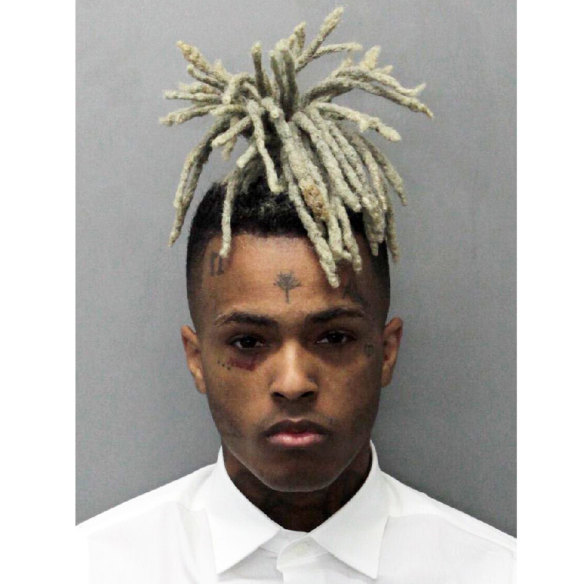
US rapper XXXTentacion was a confidant of Eilish's before he was killed in 2018. Eilish was criticised for mourning him. Credit: AP
In June 2018, XXXTentacion, a popular 20-year-old Florida rapper whom Eilish considered a confidant, was shot and killed. At the time of his death, he was awaiting trial for a 2016 domestic-abuse case involving an ex-girlfriend and had been charged with numerous acts of violence to which he pleaded not guilty. When Eilish mourned his death publicly, she was widely and loudly criticised as an abuse apologist. “My friend died,” she told me, “and then it just sucked for a year.”
Removing Billie’s foot from its perch on his leg, Finneas rose from his coffee table and moved to his computer. Four days later, at the Oscars, he would accompany Billie on piano during her performance of Yesterday, and he wanted to fine-tune a pre-recorded element. “There’s a string arrangement,” he explained. “Live strings we recorded yesterday, so I’m trying to figure out how to put them in.”
“It’s really pretty,” Billie said of the song. “There was a moment where people were like, ‘It’s too sad,’ Finneas said, “and I was like, ‘Uh, yeah!’ ”
“It’s In Memoriam!” Billie said. “They really wanted us to do Moon River, which is a beautiful song, but we were like: ‘We want people to be sad. It’s a sad thing. You should be sad when you think about people who died.’ ”
[Eilish] decided that she wanted to be famous when she was 12, when she watched the crowd cheer the young star of Matilda on Broadway.
In press coverage of Eilish’s career, much has been made of her oblique relationship to the cultural mainstream. The genuinely improbable fact that she made a smash album with just her brother, in his bedroom, and that that album is frequently creepy and morose, has been held up alongside Eilish’s outré outfit choices and constantly changing hair colour as evidence of a subversive insurrection into – and even a paradigmatic shift in – the pop landscape.
America’s NPR called Eilish a “misfit”, and Billboard called her a “rebel”. Rolling Stone, putting her on the cover last July, celebrated her rise as “the Triumph of the Weird”. When Eilish appeared on the March cover of US Vogue, the magazine referred to her as “the Outsider”.
Eilish, for her part, does not describe herself, much less seem to see herself, in these terms. To the extent it exists, her rebelliousness takes reverent and flexible forms. She decided that she wanted to be famous when she was 12, during a trip to New York, where she watched the crowd cheer the young star of Matilda on Broadway.
Eilish often cites the influence on her art of the brash and iconoclastic LA rapper-producer Tyler, the Creator, but her musical idol growing up was far more chaste: angel-voiced, mop-topped Justin Bieber.
Rather than disavow that idolatry today as an embarrassing artefact of adolescence, the way some teenagers might, Eilish instead got Bieber himself to sing on a remix of Bad Guy last year. To commemorate this collaboration, she posted a photo to Instagram of her younger self standing before four Bieber posters on her bedroom wall.
When I asked Eilish if she felt any wariness about the abundant approval she has won, as “an outsider”, from establishment show-business institutions like the Oscars, she said, “People keep trying to get something out of me that’s, like, ‘[Expletive] the Grammys, [expletive] the Oscars.’ ” She shook her head. “I have literally zero ambivalence. I’m like, ‘That’s fire …’ ”
From the start, her success has come not in spite of industry gatekeepers but with their help. After she and Finneas uploaded Ocean Eyes to SoundCloud, it received a boost from Hillydilly, a music blog with industry readers.
Finneas parlayed a friendship with the artist manager Danny Rukasin, with whom he had connected as a musician, into representation for Eilish; Rukasin, who manages Eilish with Brandon Goodman, helped score Eilish a deal with the music-discovery platform Platoon and later a contract with Darkroom, a partner label of Interscope Records, the powerhouse that has been home over the years to Eminem and Gwen Stefani.
Apple, which wound up buying Platoon in December 2018, supported Eilish early, booking her at a South by Southwest Music Festival showcase in 2017 and including her in its UpNext series, in which the company gives a chosen artist “a huge boost in visibility”, as Billboard put it, “using their editorial team’s elusive resources”.
Those resources included an Apple-exclusive live EP and an interview with Zane Lowe on Beats 1, the radio station that goes out to Apple Music’s more than 60 million subscribers. Spotify has given her special attention, too.
In 2018, Apple asked Eilish and Finneas to make an uncharacteristically uplifting song, built around a gentle acoustic-guitar riff that soars to a feel-good crescendo and lyrics about revealing your hidden gifts to the world – a vibe much closer to Ingrid Michaelson than Marilyn Manson.
The song, Come Out and Play, scored an animated commercial that Apple broadcast during the holiday season. “We’ve never written a song that was ‘empowering’, ” Eilish told me. “It was very different for us. It was weird. I was like, What the hell?”
The song didn’t quite feel like her, she went on, “but it didn’t need to feel like me, ’cause it’s an ad, for Christmas time. It’s cute. It’s not me, but it’s adorable. I think you can have something that’s not you, but it works.”
Who Billie Eilish is and isn’t are categories in flux. This is true in differing degrees for any of us, but especially for a teenager growing up in the public eye. That was ultimately the lesson that she and Finneas learnt last spring when they returned to the song about her suicide dream, which they put on ice the previous fall.
Eilish’s phone contains hundreds of voice memos documenting songs in various stages of completion – a hummed melody, a turn of phrase, a half-formed chorus. “Sometimes we’ll go through each other’s old voice memos, because there are things we’ve completely forgotten about, and this was one of them,” Eilish said, showing me the folder as she scrolled through it, stopping at April 26, 2019.
On that day, they dug up the verse they had written. “We listened to it, and we were both like, ‘Ohhh – what’s that?’ ” Eilish recalled, emphasising that by this point, emotionally, she “was in a better place”. She had been to see a therapist; she had figured out ways to make touring less punishing and less lonely, including flying friends out to meet her on the road; most simple, she said, she was that much older, with “things feeling more in your control, just your brain maturing and your mood changing”.
Of the new song, she went on, “my argument, which I think was the thing that made my mum and Finneas finally go, ‘Oh, okay,’ is I said: ‘This song is the way I can feel these things without doing something to myself …’ ”
As Eilish and Finneas revisited it, its solitary fatalism gave way to themes of stability and fellowship: “Finneas and I both had the idea to make the song about each other, instead of just me and how I was feeling,” Eilish said. And whereas in the past Eilish’s default mode has been to unsettle listeners, in the finished lyric, images of aestheticised self-destruction (“thought I could fly, so I stepped off the Golden”) alternate with lines about finding comfort in a comrade’s reassurances.
“We had a complete block,” Eilish said, “and the way we got through it was to make it about us as siblings and what we mean to each other.”
The song, Everything I Wanted, is a hushed piece of dance music – its piano riff sounds as if it’s faintly flickering, and its kick-drum pulse sounds as if it’s throbbing from the other side of a wall. Of his approach to song structure, Finneas said, “I think where a song doesn’t go is as interesting as where a song goes. Sometimes we’ll put a different verse in when it should go to the chorus, just for the slap in the face of, like, ‘Your brain has to stay awake for this …’ ”
Among other considerations, this was a useful trick for standing out in crowded streaming playlists, Finneas said, where “I think we’ve benefited from being the odd one out. When you hear a truly generic pop song – and I don’t use that word with negative connotations, just in the sense of standard – by the time you get through the second verse, you know exactly what the rest of the song sounds like.”
On the subject of the generic, he added: “There’s a production philosophy around getting really bright and really forward in choruses, but I tend to get really bass-y with Billie. I’ve been doing that all the way back to Ocean Eyes. If anything, it comes from going to concerts and hearing a 10-foot-tall subwoofer hit you, and just trying to recreate that on a microscopic level, so that it feels that way in an earbud.”
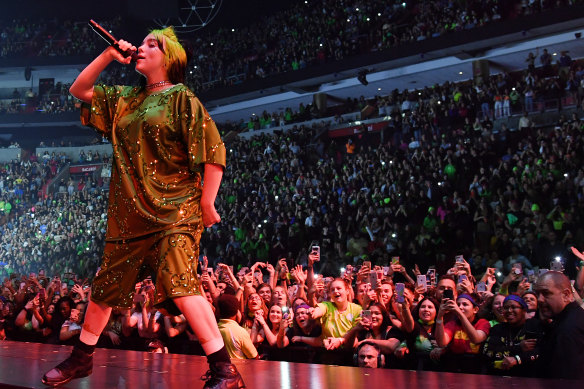
Eilish on stage earlier this month in Miami, Florida as her "Where Do We Go" world tour kicked off. It has since been postponed. Credit: Getty Images
Eruptions of bass notwithstanding, Everything I Wanted resists anything resembling a traditional climax, building only to recede, over and over, until it’s done. Describing this dynamic, Finneas used a sexual metaphor – “Billie and I have a real fixation on musical edging” – to which Eilish, who had slumped over onto her side, looking at her phone, sprang to attention, contorted her face into a mask of disgust and cried out: “Finneas, God!”
Eilish sat on a stool in a hangar-size Burbank rehearsal space the next day, holding a wireless microphone and trying to figure out how best to put her fingerprints on a song as overwhelmingly familiar as Yesterday, which she would perform at the Oscars that weekend. First, though, there were technical difficulties to overcome.
“The click is piercing my ears,” she said, pointing to her in-ear monitors, which played a metronomic beat audible to only her and Finneas, who was playing a keyboard beside her. This click was a necessity for keeping them in time, but it also functioned something like a shared secret – tethering the siblings to each other, even as the rooms around them grew big enough to swallow them whole.
Eilish was here to prepare for not only the Oscars performance but also her imminent, sold-out arena tour, which was due to kick off this month. (All Eilish’s North American tour dates in March were postponed due to the COVID-19 pandemic.) According to the trade magazine Pollstar, the tour – which was set to include nights at Madison Square Garden, Rio de Janeiro’s Jeunesse Arena and Mexico City’s Palacio de los Deportes – sold a half-million tickets in the first hour they became available.
Despite the tendency toward the small-scale and sparse in Eilish’s music, Finneas told me they were unconcerned about bringing her songs into such enormous venues: “Billie’s crowd is a real singalong crowd, so no matter how quiet the song is, there’s going to be 10, 20,000 kids screaming the whole time.”
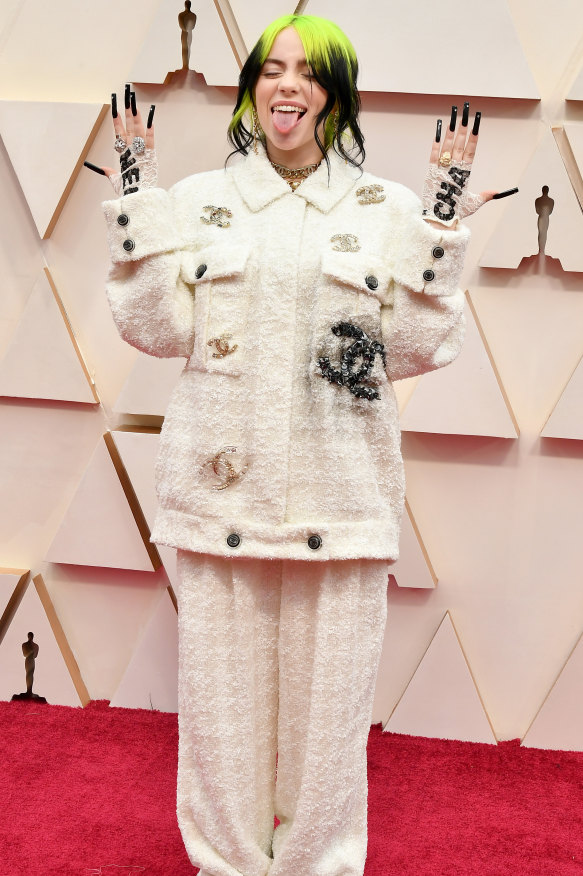
Eilish on the red carpet at this year’s Academy Awards. Her appeal has relied on combining her taste for the radical with her strong sense of the classical.Credit: Getty Images
She gave the cover a go, closing her eyes and throwing some R&B-indebted flourishes into her interpretation, from little humming vocal runs to melismatic bending on certain vowels. Facing her on a couch some 15 metres away were their parents, O’Connell and Baird. As the song ended, Eilish delivered a one-word verdict: “Yikes.” She looked at Finneas, who hadn’t given her much of a preamble before the first verse.
“Do they not want me to do the little run at the start?” she asked. “I feel like it gets me into it better.”
Of the criticisms Eilish reads about herself online, one of the most irksome is that her spectral delivery hides a fundamental lack of technique and power – “She can’t sing, she just whispers,” as she paraphrases it – and with this performance, it emerged, she planned to do a little showing off.
Finneas told her that the cameras would be on her only at the start and finish of the song, cutting to the In Memoriam montage in between. “Everyone thinks I can’t sing on the internet,” she replied, “so I want to move the runs up to when I’m on camera.” From the couch, Baird reassured her: “Your voice is so beautiful. The internet are idiots.”
Going into rehearsals, I had imagined Eilish approaching Yesterday something like the way Johnny Cash approached his austere cover of Nine Inch Nails’s Hurt, or the way Cat Power approached (I Can’t Get No) Satisfaction – reinterpreting it as something haunted and hollow, drained of affect to the point of near monotone, the burn of the original reduced to a shivering ember.
But for an artist who presents as idiosyncratically as Eilish, her ambition for this performance turned out to be unabashedly conventional, respectful both to the source material and to the gig at hand.
A pop star’s job, on a generic level, is to provide comfort – to situate listeners within an experience of familiar emotions communicated through familiar structures, which might be subverted or tweaked but only to the degree that they grab our attention and take up residence in our brains that much more effectively.
From the start, Eilish’s appeal has relied on combining her taste for the radical with her strong sense of the classical. In Everything I Wanted, what started as a song about profound disorientation ended up as a song about profound stability. When you listen to that single, or watch Eilish sing Yesterday, it becomes clear that for her – for now, anyway – pop isn’t something to sabotage. It’s something to hold sacred.
It was time for another run-through, which Eilish festooned with more wordless acrobatics up top, and which was met with more clapping, cheering and another round of compliments. Through the applause, Eilish frowned and shook her head, and when it subsided, she rolled her eyes.
“Blech,” she said, sneering. Maybe she was being hard on herself; maybe an eminently sane response to adulation is to doubt it. But later she told me it sounded pretty good to her, too.
Edited version of a story first published in The New York Times Magazine. © 2020 The New York Times.
To read more from Good Weekend magazine, visit our page at The Sydney Morning Herald, The Age and Brisbane Times.